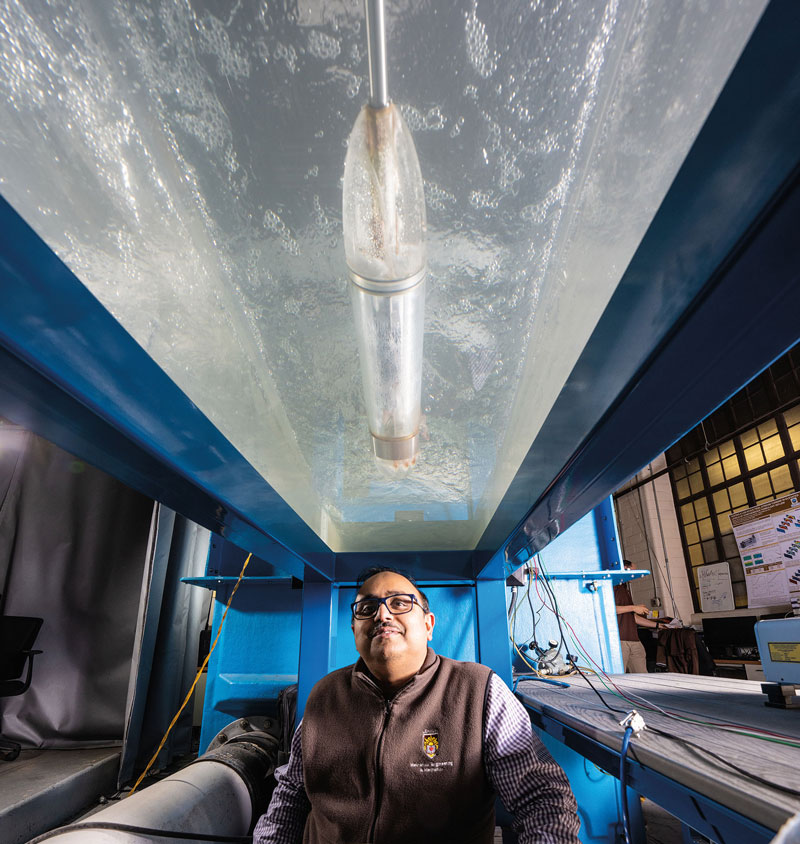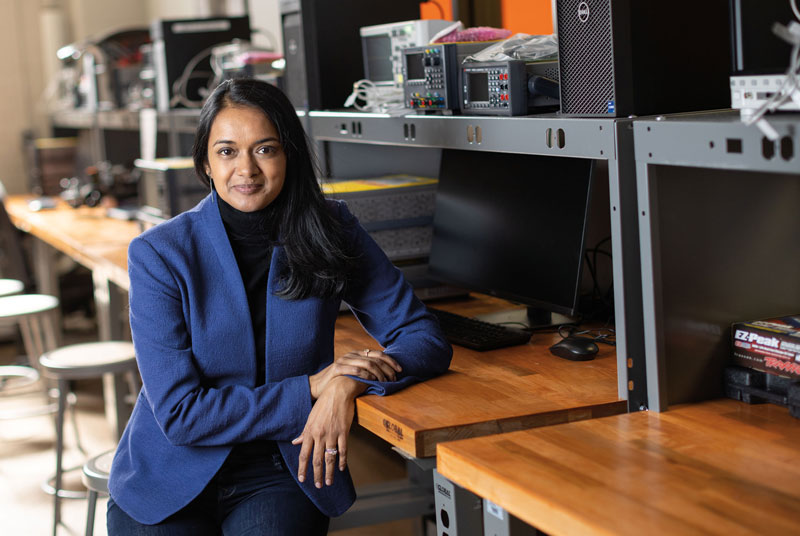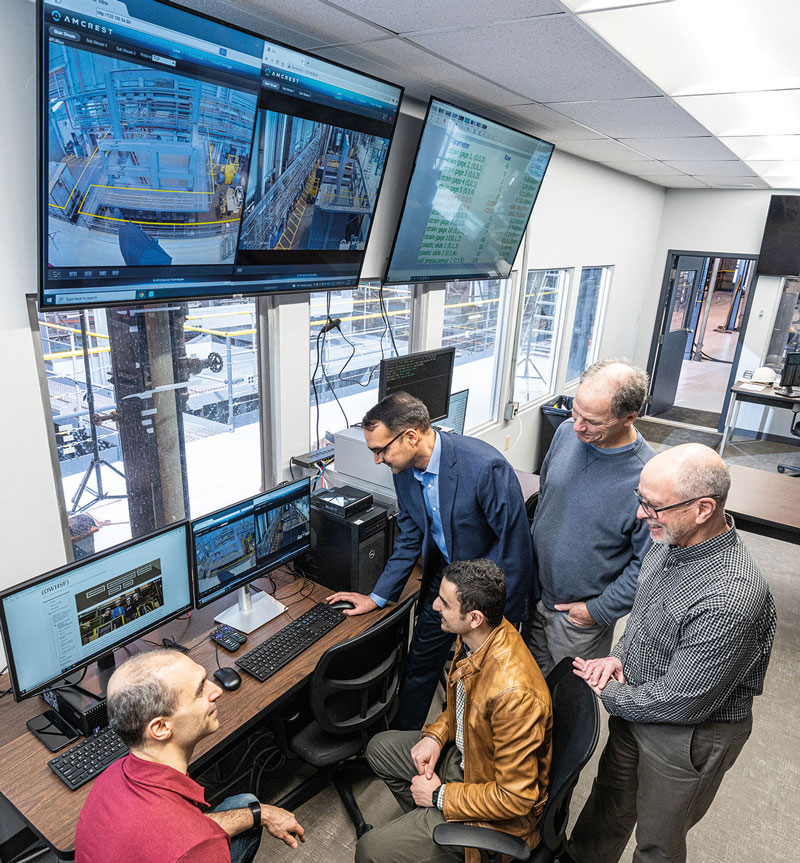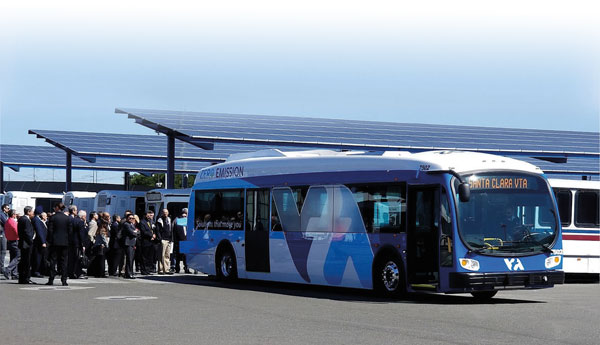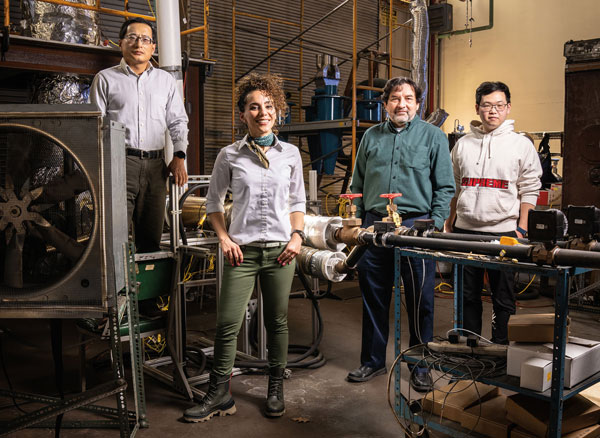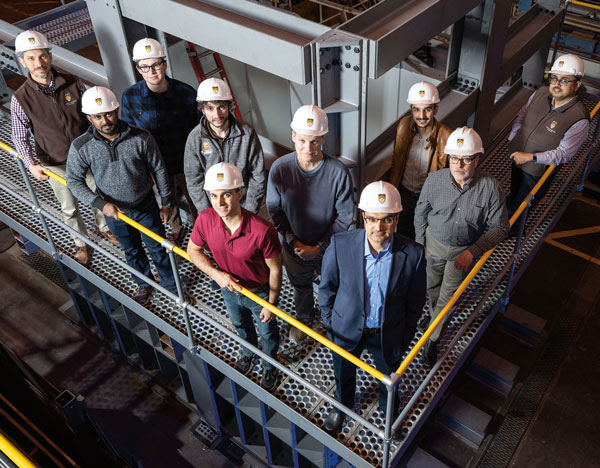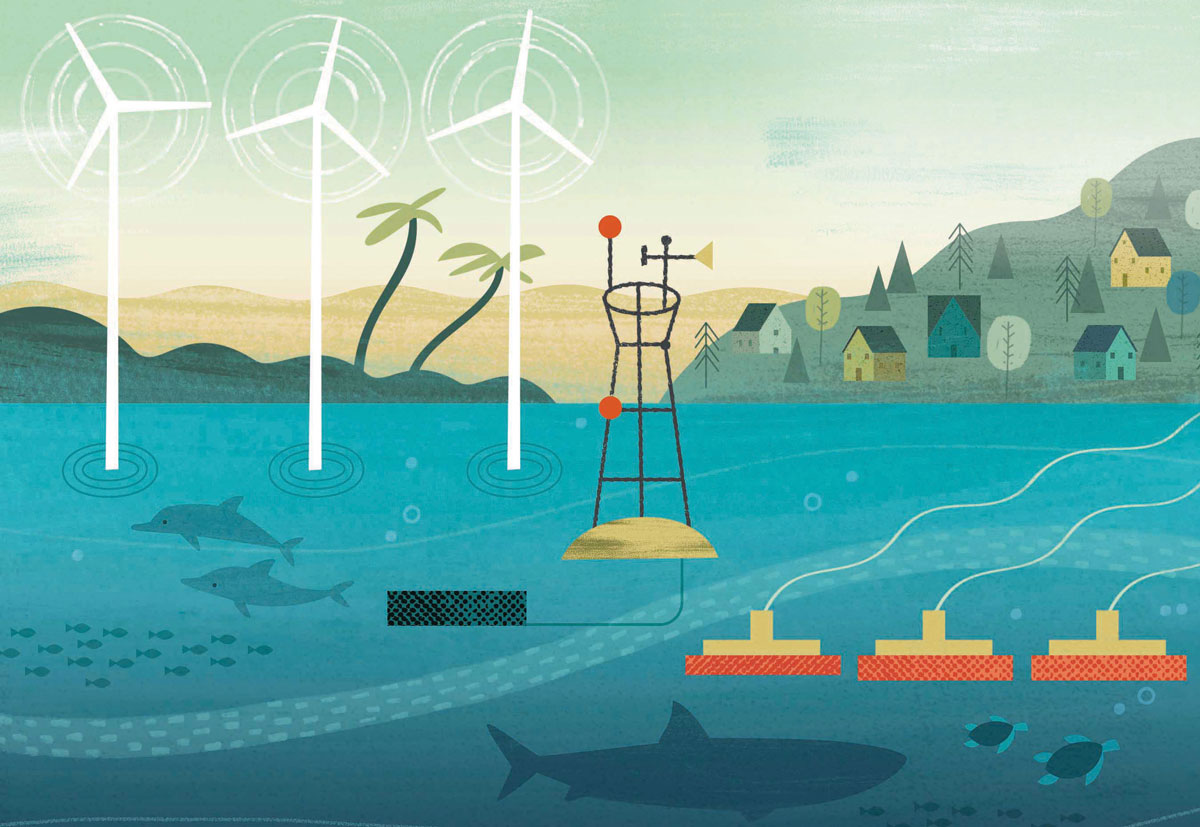
Lehigh takes a leading role in the new DOE-funded Atlantic Marine Energy Center, charged with harnessing renewable power from the ocean.
|
AMEC will allow Lehigh to make improvements to testing infrastructure like Banerjee’s tidal turbulence testing facility, which mimics tidal site conditions. (RYAN HULVAT/MERIS) |
Illustrations by Dante Terzigni
In the face of climate change and environmental degradation, how can we maintain the health of our oceans and the communities that depend on it? In the U.S. alone, nearly 40 percent of the population lives in coastal areas, according to the National Oceanic and Atmospheric Administration.
It’s one of the questions at the heart of what’s known as the “blue economy,” a concept focused on the sustainable use of ocean resources to promote economic growth, improved livelihoods, and the health of marine ecosystems. And according to the World Bank, it encompasses activities related to maritime transport, fisheries, tourism, waste management, climate change, and renewable energy.
Lehigh engineers have long been working in the field of renewable energy, often as part of interdisciplinary teams. Instead of looking at problems within the silos of their respective disciplines and focusing on individual components, they’ve used a holistic approach to design system-wide solutions. That process and expertise was recognized in late 2021 when Lehigh, together with three other academic institutions, was awarded a four-year, $9.7 million grant from the Department of Energy (DOE) to create the Atlantic Marine Energy Center (AMEC). It will be one of only four National Marine Renewable Energy Centers in the country.
The grant reflects the university’s leadership in the field, says professor Arindam Banerjee, chair of the Department of Mechanical Engineering and Mechanics and co-leader of AMEC. “I think Lehigh is at the forefront when it comes to solving these energy challenges,” he says. “And now with AMEC, we’ll be advancing collaboration in the marine renewable energy sector to provide engineering solutions to developers who power the blue economy.”
There’s a broad range of potential applications for marine renewable energy (MRE). For example, adding a wave energy device to ocean observation buoys currently powered by batteries would reduce the need for servicing conducted by fossil-fuel-burning ships. Similar devices could recharge autonomous underwater vehicles while at sea, allowing them to stay on mission longer. Fish and marine algae farms could generate their own electricity instead of relying on traditional fuels brought in by boat. MRE devices would help run desalination facilities for island communities. And they could offset the extraordinarily high prices these communities currently pay for electricity; rates that Banerjee says can be nine or 10 times that paid by mainland customers.
“Our goal is to try to understand, what are the blue-economy applications?” says AMEC co-leader Shalinee Kishore, Iacocca Chair Professor of Electrical and Computer Engineering and associate director of Lehigh’s Institute for Cyber Physical Infrastructure and Energy (I-CPIE). “What kind of demand do they have for electricity? How does it match with what marine renewable energy systems will deliver, and how do you offset the difference between the two by using energy storage in the best way possible?”
Increasing reliability, reducing cost
The Lehigh AMEC team comprises faculty members representing mechanical, electrical, computer, industrial, civil, and structural engineering. Members of the team, including Banerjee and Kishore, have collaborated on previous work, funded by the NSF, that showed the viability of bringing ocean wave energy to the grid. One aspect of that study involved looking at how to design a farm of sorts of multiple buoy-like devices to maximize their hydrodynamic interaction.
“Imagine you have one device heaving up and down from the ocean waves,” says Kishore. “That device ends up creating its own waves. The device downstream from it will get those waves in addition to the ocean waves. It’s possible these add up constructively and the second device gets more energy, but it could get less because waves can add up constructively or destructively. One aspect of that project was to design these farms in a way that enabled more energy conversion, so the hydrodynamic interaction was positively correlated.”
|
As co-leader of AMEC, Kishore will focus on energy storage and how to better tune that storage to the electricity demands of various blue-economy applications. (DOUGLAS BENEDICT/ACADEMIC IMAGE) |
The other aspect of the project involved bringing that energy back to shore and integrating it into the power grid, which required understanding what it meant for electricity generators and grid operators to manage ocean wave energy versus wind or solar power.
“So from the grid operator’s perspective, when a lot of solar and wind comes onto the grid, it’s great, because it’s low-cost renewable energy. The downside is that you can’t control it,” she says. “One of the major benefits of ocean wave energy is that it’s much more predictable than solar or wind. But we also recognize that marine renewable energy systems are still expensive. So one of the goals of AMEC is looking at how to develop these systems at scale and reduce cost.”
It’s not an easy proposition. Decades of research and development coupled with government subsidies have driven down the cost of wind and solar energy and made them a viable choice for consumers. MRE devices capable of delivering grid-scale power are still 10 to 15 years away, says Banerjee.
The next step then might be to develop MRE systems for use within island communities where the cost of energy is already high, says Kishore. The actual components might still be expensive, but the operational costs will be low, as the communities make use of the abundant energy source that surrounds them.
“As an example, people on islands in the Northeast, like those in the Gulf of Maine, pay up to nine times more than mainlanders, which means a ridiculous amount of their monthly income is going toward electricity,” says Kishore. “And that’s because cables have to bring that electricity to the island, or fuel needs to be brought in to operate their generation resources. Drinkable water is an issue in these places, too. Water remediation is very energy intensive. So now we’re no longer talking about esoteric blue-economy applications. We’re talking about places that are energy poor and people who experience scarcity when it comes to the electricity they need to run their homes, provide their drinking water, and give them internet access.”
That next step involves more than just the development and deployment of MRE technologies, says Banerjee. It requires studying the intricate interdependencies between communities, energy, water, and communications. He envisions the scope of the Lehigh AMEC team expanding beyond its current mandate of powering the blue economy to address socioeconomic problems related to the blue economy. At the heart of those questions are interdependencies related to the energy-water-communications network.
“One of our goals is to move into research questions associated with these interdependencies,” he says. “I can sit in my office and say a certain coastal community needs energy to run a desalination system. But what are the issues surrounding that need? Is there a bottleneck associated with the power required to run that system? How will renewable energy affect the utility companies on these island communities and their power grid? Or if we’re talking about fisheries, what is the energy resource that industry thinks would best suit its needs? There are stakeholders associated with each of these problems, and as engineers, we don’t fully understand their scope. We have expertise in communication networks, water systems, and energy systems. So we’re building a bridge between those areas and going after these grand challenges.”
For Kishore, who will be focusing on energy storage systems, it will be an opportunity to learn how to better tune storage to the electricity demands of various blue-economy applications. It’s also an extension of the work that the Institute for Cyber Physical Infrastructure and Energy has been doing for quite a while now.
“In I-CPIE, we talk about how the physical components, the sensors, and the algorithms that run these infrastructure and energy systems all have to be designed to better meet the needs of the folks that they serve,” says Kishore. “It’s not just about technology, it’s also about the communities that technology is designed to impact. And I feel like all of that comes together really nicely in this particular space with AMEC.”
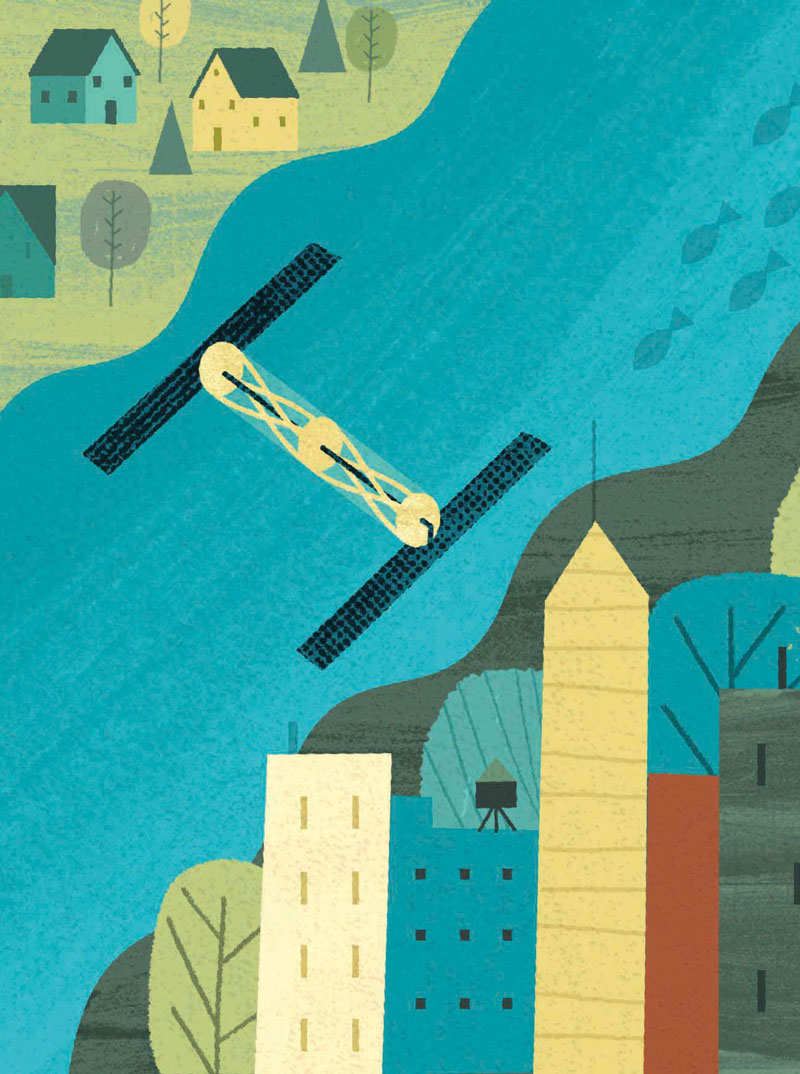 Examining energy equity
Examining energy equity
Grand challenges are often largely in pursuit of equity. And achieving equity is, in part, an optimization problem.
Indeed, making energy and water more affordable and sustainable for coastal communities requires co-optimizing those objectives with the related infrastructure, says Farrah Moazeni, an assistant professor of civil and environmental engineering, and one of the theme leaders of AMEC. Moazeni and Javad Khazaei, an assistant professor of electrical and computer engineering, will be studying interdependent critical infrastructures, particularly the interplay between water systems and infrastructure like that related to electricity and transportation.
Historically, she says, these utilities have been optimized individually. Lehigh’s approach will be to look at them as a whole.
“For example, how can you convert saline water to drinking water without increasing the electricity consumption?” says Moazeni. “We want to see if we can co-optimize all this infrastructure at the same time to minimize energy consumption, minimize freshwater consumption, and enable these communities to operate off grid.”
The ultimate goal—“my dream,” she says—is to close the loop. To enable ocean communities to use waves to create the energy that runs their homes and desalinates their water and powers their wastewater treatment. In the meantime, she believes that the optimization work she and her team will be doing will help many of those communities paying exorbitant rates for energy by making systems more efficient and thereby reducing costs.
“Many people don’t have easy access to these resources, so this is really about energy and environmental equity, and that’s what I find so compelling about trying to solve these problems,” she says. “If we could offer a model that could reduce energy consumption by 30 percent, that will make a huge impact not only on sustainability but on people’s lives.”
|
Clockwise from left, Thomas Marullo, Suleiman, James Ricles, Sause, and Qasim Abu-Kassab in the control room for the offshore wind multidirectional soil-foundation interaction testing facility. (RYAN HULVAT/MERIS) |
Upgrading research infrastructure
With AMEC’s creation, Lehigh will be making significant improvements to its testing infrastructure. One of those upgrades will take place in Banerjee’s tidal turbulence testing facility. The system mimics tidal site conditions, but it currently can’t replicate the flow velocities in high-energy sites.
“So we’re going to speed up the water tunnel in Packard Lab to get the kinds of velocities you would have in open-water tidal sites like the East River in New York City where the flow is between 1.8 to 2.4 meters per second,” says Banerjee. “We’re aiming to get up to 2 meters per second.”
Improvements will also be made to two test bed facilities within Lehigh’s Advanced Technology for Large Structural Systems (ATLSS) Engineering Research Center. One, led by Richard Sause, will conduct fatigue loading on tidal turbine blades. Sause is the Joseph T. Stuart Professor of Structural Engineering and also serves as director of ATLSS and the Institute for Cyber Physical Infrastructure and Energy.
“Right now, there’s only one test bed like that in the United States, and it’s in Golden, Colorado,” says Banerjee. “So if you’re a developer, that’s the only place you can go to get that testing done.”
The second ATLSS improvement will be to a soil test bed for marine foundations. In 2019, an I-CPIE team, led by Muhannad Suleiman, a professor of geotechnical engineering, received a DOE grant to upgrade Lehigh’s offshore wind multi-directional, soil-foundation interaction testing facility and its structural-testing and modeling capabilities. The award supported better understanding of the behavior of offshore wind turbines, specifically as it relates to the unique weather and geology of the coastal United States (see "Tackling Offshore Wind Challenges ‘From the Ground Up'"). AMEC will further support that work as it pertains to underwater turbines; in particular, how these marine energy structures and their foundations will interact with the soil.
"There are a lot of unknowns when it comes to generating energy from water," says Suleiman, who is a member of the AMEC team. "I'll be focusing on water-soil-foundation-structure interaction and how to support these structures in a river environment versus an ocean environment. We need to consider erosion and the impact on biological systems. We also want to explore the feasibility of designs for foundation systems that are economical, reliable, and resilient. We may design them for the behavior of today, but do we really know how they’ll behave in 20 years? Also, we could design a system that might not fail, but may deform or displace with time, reducing its energy output. That’s not a resilient infrastructure."
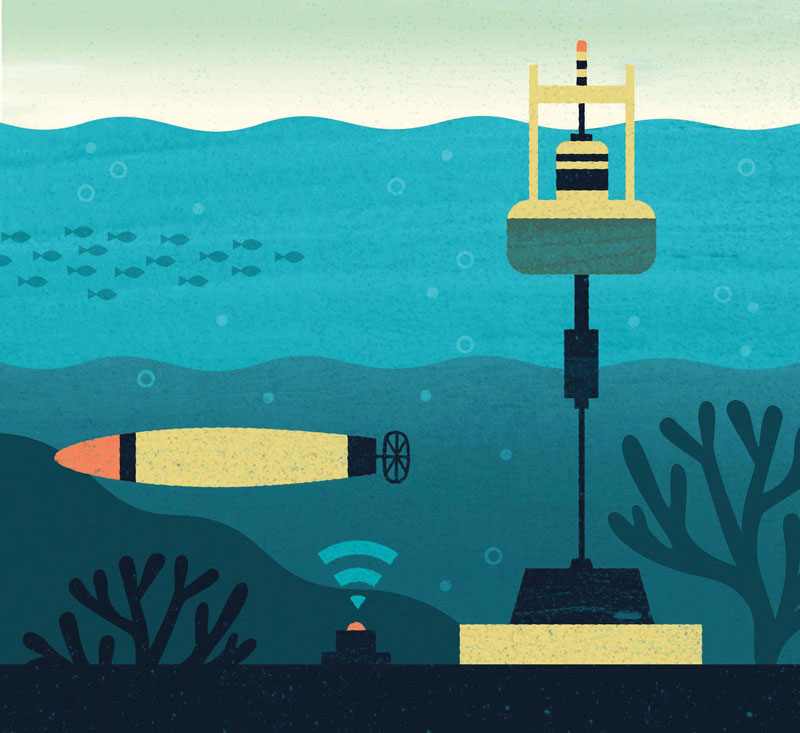 Problem-solving across disciplines
Problem-solving across disciplines
The interdisciplinary team is uniquely positioned to address these many unknowns, from the component level to structural behavior, to energy harvesting and storage, to stakeholder concerns, supply chain, and resiliency.
In addition to Banerjee, Kishore, Sause, and Suleiman, the team also includes industrial and systems engineering (ISE) professor Larry Snyder and civil and environmental engineering (CEE) professors Panayiotis “Panos” Diplas and Paolo Bocchini. These collaborations are expected to expand as Banerjee and Kishore form a team that will address interdependence problems in energy-water-communications networks. This team would include Moazeni and Khazaei, College of Arts and Sciences professor David Casagrande (sociology and anthropology), and Rossin College faculty members Y.C. “Ethan” Yang (CEE) and Karmel Shehadeh (ISE).
“It’s a unique group,” says Banerjee. “And that’s what makes us one of the leaders in this field. There’s just so much expertise, and at Lehigh, there aren’t any barriers in doing these cross-disciplinary collaborations.”
Those collaborations may soon extend to Lehigh’s College of Health and College of Business. Banerjee says they’ve had preliminary discussions with affiliated faculty members, specifically around questions of energy justice.
“When you look at rural communities or island communities where the cost of energy is really high, people often end up making poor choices about their power resources. They might use diesel generators or burn wood for heat. And these choices can have adverse health effects. So if you just look at the problem from that perspective, the type of solutions we are providing through AMEC could be used to address broader questions around health and equity.”
While the AMEC grant will be used in part to enhance his own research facility, Banerjee’s position with the center allows him to step outside the lab and pursue leadership opportunities that can help grow the industry.
“I’m now at the policy-making table where a lot of these decisions are being made around the blue economy,” he says. It’s a position that has coincided with Banerjee recently being named associate editor of the journal Renewable Energy. Over the course of a year, he oversees the review of nearly 600 submissions from researchers around the world in the area of offshore renewable energy, a portfolio that includes both wave/tidal and offshore wind energy.
“In my role, I get to see what people are doing around the globe, which allows our team to reach out to researchers who are working in marine renewable energy,” he says. “And that will give Lehigh international visibility.”
Successful partnerships depend on a knowledgeable workforce. And to that end, as a department chair, Banerjee is also now focused on how to best prepare students to meet the needs of this rapidly evolving industry. He envisions a time when companies will be recruiting a minimum of 10 Lehigh engineers every year.
“So in preparation for that,” he says, “we need to make sure we’ve got the proper courses, grants, and research opportunities that will allow our students to compete for those jobs.”
There are plenty of challenges that lie ahead in the development and deployment of marine renewable energy devices and structures. But as climate change continues to alter our coastal systems and communities, there is the possibility that some of those changing weather patterns can be utilized for good, and seen, at least in part, as opportunities. Opportunities to harness the rising tides and broaden our capacity to generate reliable electricity—and improve the day-to-day lives of millions of people. It may not happen in his lifetime, but Banerjee is optimistic.
“I’m hopeful that our children will live in a world where these technologies are regularly being used and are a viable part of their energy portfolio.”

